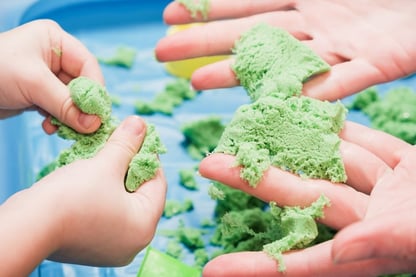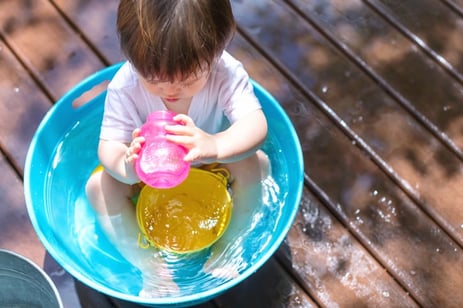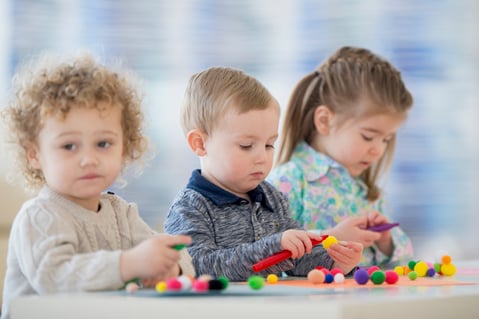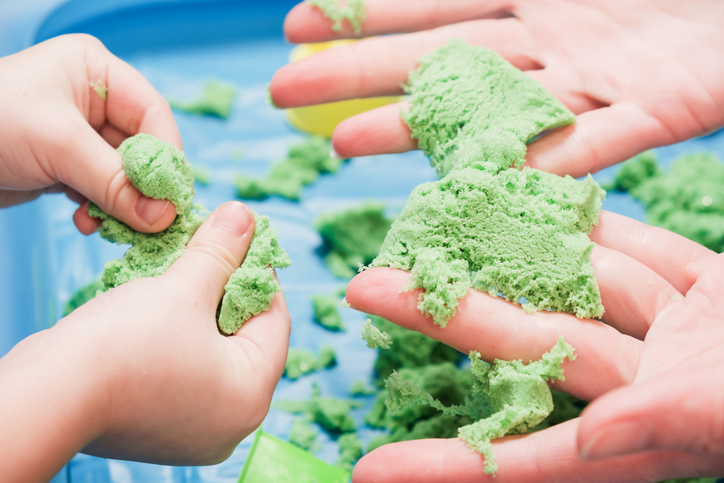The 7 Benefits of Using Sensory Bins for Autistic Children
Has your family been introduced to sensory bins yet? They are all the rage at our house, and sometimes they keep us busy for hours! If you have not heard of sensory bins, or have not started using them yet, you may want to jump on the bandwagon, and I will tell you why!
Sensory bins can be extremely beneficial for autistic children. These bins provide sensory input as a calming activity, and they also provide many opportunities for learning and exploring. They are great for practicing fine motor skills, exploring new textures, improving imaginative play, providing opportunities for dialogue, or even working on those imitation skills.
Sensory Bin Fillers
First, let’s talk sensory bin fillers! Did you know that the sense of touch is the first sense to fully develop in children? Some great options for edible fillers are cereal, pasta, and rice. We even like to make rainbow rice with food coloring for enhanced visual stimulation. I have seen many autistic children enjoy paper shreds, pom poms, beans, sand, or water. The opportunities to be creative here are endless.
 You know your child best! If you have a child who likes to rip books, you may want to engage in a sensory bin using paper shreds. While ripping the pages out of books is not calming or satisfying to you, it can be the opposite for a child who is sensory seeking. This also provides an opportunity to say, “We cannot rip our books, but we can rip this paper.” You may also find that after providing the sensory-seeking opportunity, they no longer feel the need to rip the books!
You know your child best! If you have a child who likes to rip books, you may want to engage in a sensory bin using paper shreds. While ripping the pages out of books is not calming or satisfying to you, it can be the opposite for a child who is sensory seeking. This also provides an opportunity to say, “We cannot rip our books, but we can rip this paper.” You may also find that after providing the sensory-seeking opportunity, they no longer feel the need to rip the books!
One of our absolute favorite sensory bin fillers is kinetic sand. This sand is a great way to allow children to learn about the world through touch. One of the things that makes it so appealing is that it is relaxing, fascinating and therapeutic. What is it that makes this fun tactile substance a favorite amongst young children and what are they learning while exploring it? When a child molds with kinetic sand, the experience is always positive. There is no right or wrong way to do it, so they always feel successful with their creations.
So, what is it that makes these bins so great?
Here are 7 major benefits of using sensory bins:
1. Fine Motor Development
Fine motor refers to small muscle development which enables a child to hold a pencil or button a shirt. It includes eye-hand coordination and eye-finger coordination, finger strength and control, as well as the development of muscles such as the toes, tongue, and eyes.
Little ones can use sensory bin fillers to scoop, pour, mold, roll, squish, flatten, pinch, rip, and break. We also love to add utensils like plastic scissors, rolling pins, cookie cutters, measuring spoons, and plastic knives to further develop fine motor skills.
2. Vocabulary
As little ones work on their creations, they form new ideas and concepts which provides an opportunity for new words describing what they are doing and what they are making. Here you not only have the opportunity to build vocabulary but also to simply connect verbally to a child. This can be a very important step for autistic children.
3. Creativity
When working with sensory bins, little ones have a blank canvas waiting to be molded and shaped into something unique. Whether creating an image they hold mentally or re-creating something they have seen, their creations will always look different. Here you have an opportunity to add some imagination using different themes by adding items such as vehicles, dinosaurs, plastic ice cream cones, letters, or animals.
4. Counting and Sorting Skills
Adding objects or measuring spoons provides a great opportunity to talk about numbers and teach children about math and measurement. When providing a sensory bin of pom poms or beans, you can count and sort them into different containers by numbers, colors, or both; “put 3 blue poms into the blue cup.”

5. Concentration
Sensory bins are a quiet and calming activity that requires children to sit still for a certain period. This is great for lengthening a child’s concentration span over time. For children that struggle in this area, start smaller, maybe by placing sand on a children’s level table so they can stand while playing.
The more involved they are in what they are creating, the longer they will stay engaged. You may need to explore multiple fillers and objects before you find the right one! When you do, save this idea for specifically working on concentration. Soon you will begin to notice they are concentrating and making changes until it is just the way they want it!
6. Science concepts
Playing with sensory bins can be a great introduction to science concepts. The texture can be changed by experimenting with varying the ingredients or adding water to make it harder, softer, more watery, etc.
In addition, we have used our sensory bins to explore the ocean, space, volcanoes, and dinosaurs!
7. Therapeutic value
As previously mentioned, a sensory bin is an activity that provides a positive experience. The very nature of the substances makes it calming to play with. Few adults can even resist engaging with sensory bins when they come across one, which also makes it a great time to interact and bond. Sensory bins can be a great stress reliever and perfect for calming down a child and transitioning them from noisy play to some quiet time and relaxation!

Here is a great tip to add to your experience. We use plastic storage bins to create our very own sensory boxes. For Valentine’s Day, we added some wood-shaped hearts and some colorful red and white pom poms to our bucket. You can keep it as simple as you would like or make it a huge adventure. The children at my daycare like to play with their construction trucks in their bins and also like to play ice cream shop!
If your child seems uninterested at first, it is okay to introduce the bin for a short period, even just five minutes, and then remove it. Children in general and especially our sensory seekers may need time to build their curiosity. You may also need to explore different fillers and materials until you find the right ones.
I find that natural kinetic sand, paper shreds, or just water are the most calming fillers to use. Bright colors are sometimes overstimulating, but they can be great in moderation for learning colors. For example, rainbow rice. There are a ton of options and theme ideas, but sometimes the simplest bins are the best!
Check out the STAGES® Learning Sensory Builder: Sensory Kit here.

Marianne Coppola
Marianne Coppola, MHA, ABA works as a child development specialist with toddlers and pre-schoolers. She is passionate about early intervention and finding creative and engaging ways to help children reach developmental milestones. Her work extends to children diagnosed with Autism Spectrum Disorder, Attention Deficit Hyperactivity Disorder, Sensory Processing Disorder, Social Anxiety, and Motor Development Delays. She holds an M.A. in Healthcare Administration, and an M.A. in Special Education and Applied Behavior Analysis. She is currently studying to become a Board-Certified Behavior Analyst and is pursuing a PhD in Behavioral Health.




